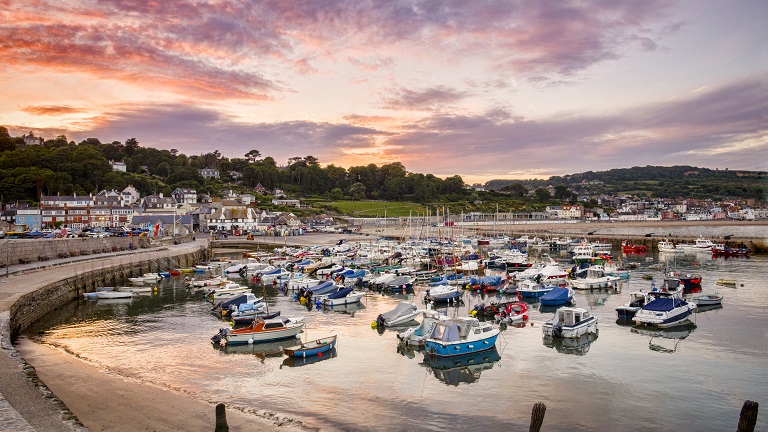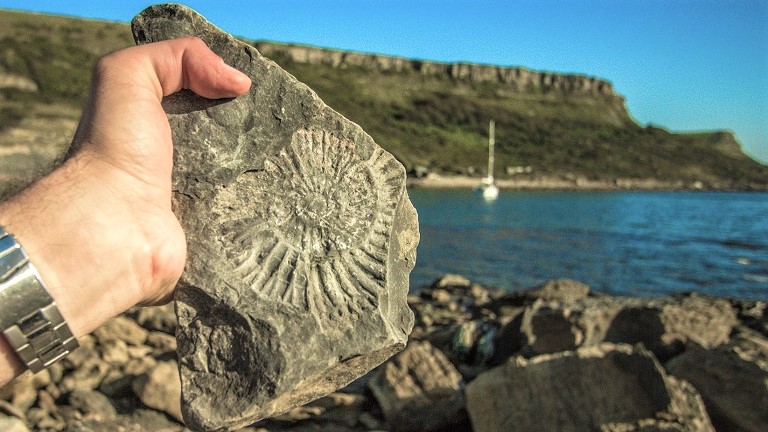Sandwiched between the East Devon and Dorset Areas of Outstanding Natural Beauty, Lyme Regis is the poster-town of the Jurassic Coast World Heritage Site. As famous for its natural beauty as its geological and historical importance, the coastal town’s cliffs reveal secrets about life here nearly 200 million years ago.
Located at the mouth of the River Lym, the picturesque seaside town of Lyme Regis is one of the Jurassic Coast’s most famous destinations.
About Lyme Regis
One of Britain’s most important ports in the 13th century, Lyme Regis has for hundreds of years been a thriving settlement – although its roots can be traced as far back as the 8th century. With a history full of soldiers, smugglers, sailors, and scribers, its cobbled streets and splintering roads have long thronged with activity and the drum of busy footsteps. That said, it’s the town’s deeper past that attracts the most attention.
Dubbed the ‘Pearl of Dorset’, the coastal town of Lyme Regis is a magnet for fossil hunters. At the centre of the county’s Jurassic Coast, its crumbling cliffs reveal an extensive past, with fossil finds detailing what life was like here 180 million years ago and more. Only 200 years ago, the discovery of a 17ft ichthyosaur fossil really placed the area on the global map for geologists. So well preserved was the fossil that the contents of its last meal could still be seen inside its belly.
The fossil’s discoverer, Mary Anning, was a self-taught palaeontologist who lived in Lyme Regis. As well as the ichthyosaur, she also found the first complete skeleton of a plesiosaur – a long-necked marine reptile – and the UK's first ever remains of a pterosaur – the biggest-ever flying animal. To this day, fossils can still be found strewn along the coast. While taking fossils from the cliffs is strictly verboten, the shores of Lyme Regis beach are one of the best and safest places to comb in the country and provide a really enoyable, unique experience in Dorset.
The Cobb

One of the most well-known features of Lyme Regis is its harbour, called the Cobb. First built from oak and boulders in the 1300s, it has been relentlessly pounded by the sea over the centuries and destroyed and rebuilt countless times. Today, the majority of the Cobb’s body is made up of Portland Admiralty Roach – a type of local limestone – and dates from the mid-1800s.
If you visit Lyme Regis on a fine day, it’s great to wander out onto the Cobb and take in the far-reaching views of the Jurassic Coast. That said, even when it’s grey and overcast, you can still appreciate the harbour’s atmosphere. Exuding history and romance, it was actually used as the setting for scenes in the screen adaptations of John Fowles’ The French Lieutenant’s Woman and Jane Austen’s Persuasion.
The Beaches
.jpg)
Of course, some of the most attractive features of Lyme Regis are its beaches, appealing to all generations. With not one but four different beaches to choose from, including Town Beach, East Cliff Beach, Church Cliff Beach and Monmouth Beach, beachgoers are spoilt for choice. And, just as exciting for four-legged companions, all but Town Beach are dog-friendly year-round.
For budding geologists and palaeontologists, Town Beach, East Cliff Beach and Monmouth Beach are the best for fossil-hunting (though much care must be taken at East Cliff due to very unstable cliffs and mudflows), and for convenience, Town Beach and Monmouth Beach are best for their facilities. From the Cobb itself, you can also take rib rides for a whole new perspective of the Jurassic Coast.
Food and Drink

One of the best parts about being on holiday is sampling the local produce. Thankfully, Dorset is known for its fruitful bounty and Lyme Regis in particular has many wonderful places to eat and drink. Offering a wide range of restaurants and pubs, bistros and bars, there is somewhere to suit every taste and occasion – from vinegar drizzled chips on the Cobb to gourmet seafood.
For a full foodie tour of the town, pick up fresh bread, pastries, cakes and savouries, as well as craft beers, artisan cider, wines and soft drinks at the Town Mill. Along Broad Street, you’ll be able to find organic foods, Dorset fudge and Italian ice cream, while on the Cobb you can visit the Wet Fish Shop fishmongers for the local catch of the day.
Town Attractions

No trip to Lyme Regis would be complete without visiting the local museums. The Lyme Regis Philpot Museum caters for all ages and showcases exhibitions on Jane Austen, the history of the Cobb and, of course, dinosaurs. Built on the site of Mary Anning’s former home, it has plenty of information about the world-famous collector herself, fossils and the Jurassic Coast. Another time, if you haven’t managed to unearth any fossils on the beach, you can head to one of the town fossil shops and peruse the collections for sale.
To get you out and about, many guided fossil walks are available, providing a fun, safe and informative way of learning about and discovering local fossils. The beaches naturally offer plenty of leisure and play opportunities with both sandy and pebble options, while local paddle board tours and kayak hire give you the perfect chance to explore the coast and burn some steam. If you have time, you can also visit the Lyme Regis Marine Aquarium to discover present-day life beneath the waves.
Feeling inspired? Take a look at our luxury cottages in Dorset here.